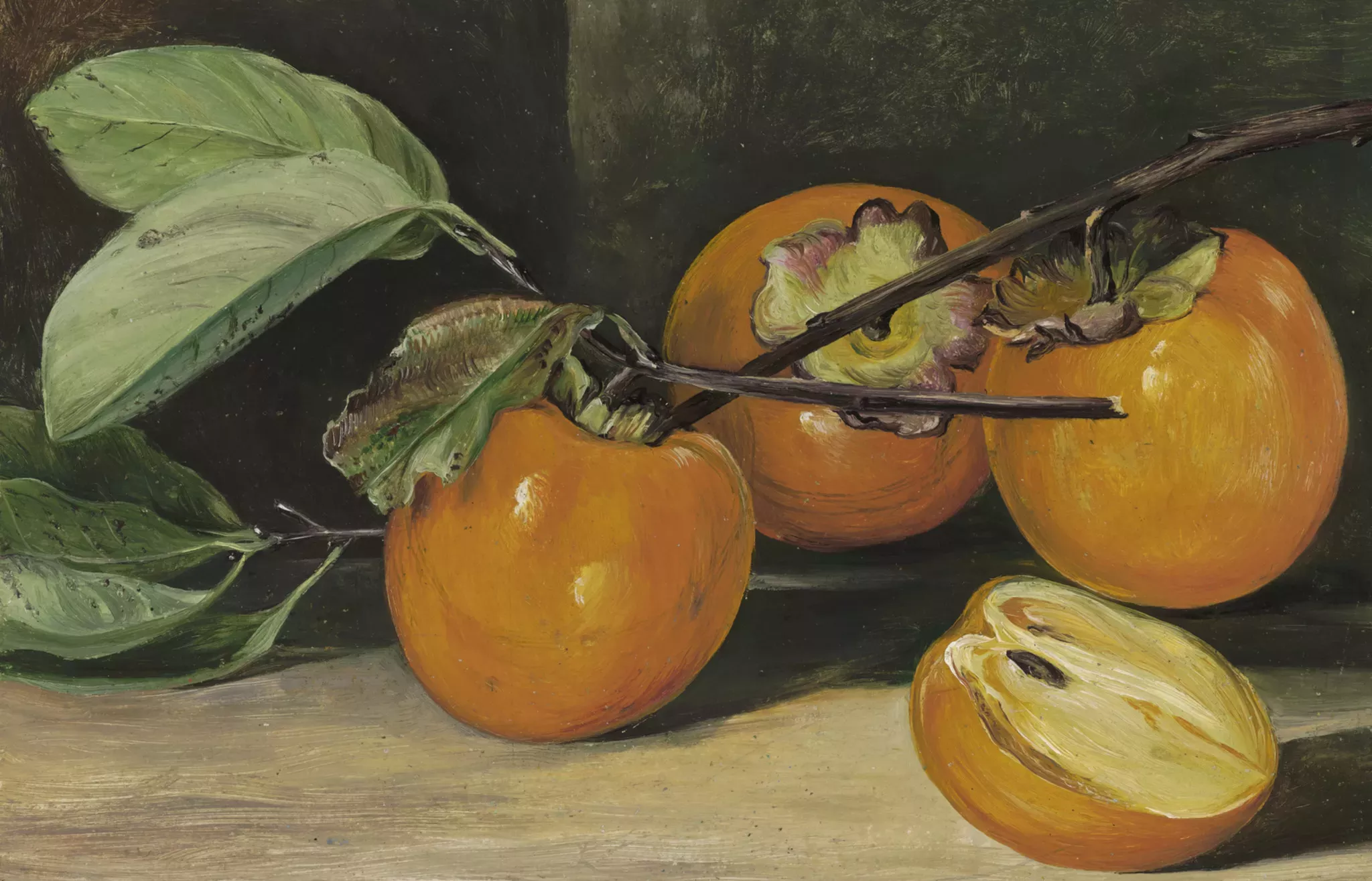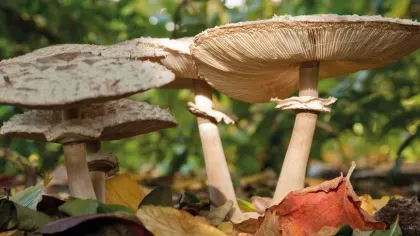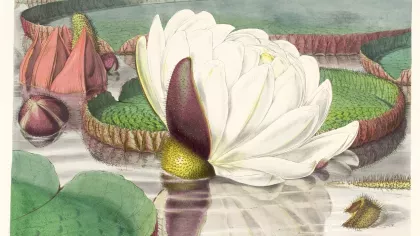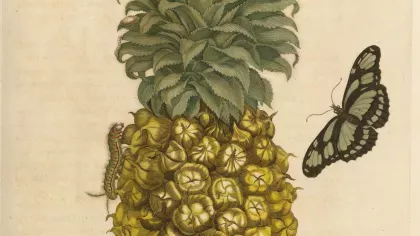9 November 2017
Marianne North’s Japan
A look at Marianne North’s depictions of Japan, which represent the country as she saw it in 1875.

A winter’s journey east
The Marianne North Gallery showcases paintings by the Victorian artist and explorer Marianne North, made during her travels to fifteen countries in fourteen years (1871-1885) documenting the flora and culture of Europe, Asia and the Americas.
During her time in Japan, Marianne North set in paint the unspoilt atmosphere of the country at a point when many parts still had restricted access for foreign visitors. She captured both the rich red and gold interiors of Buddhist temples and the gardens they were set within, noting distinctive features such as how in Kobe a horse was kept at the temple 'in case God came down and wanted a ride'. Her still life compositions included Japanese fruits such as the Kaki fruit, its shiny orange skin hinting at the smooth juicy flesh beneath, and floral arrangements of chrysanthemums laid in front of a dwarfed pine or bonsai tree. She succeeded in capturing the character of Japan in both these close-up studies and her wide ranging landscapes, such as her dramatic composition which sets Mount Fujiyama as a crisp icy peak stretching through clouds and framed by lilac wisteria.
The mountain was Marianne North’s first sight of Japan when she arrived in early November. She writes of this initial vision of the Japanese landscape in her Recollections:
"I watched the sun rise out of the sea and redden its top, as I have seen so well represented on so many hand-screens and tea-trays. The mountain is a much steeper cone than Teneriffe [sic] or Etna, but has about the same quantity of snow on it. The coast is beautifully varied with ins and outs, islands and rocks, the cliffs everywhere fringed with trees and higher than I expected to see them, the water of the clearest aquamarine."
North was fascinated by Japanese culture, enjoying Japanese teahouses and miniature gardens alongside her painting expeditions. Japan also provided her with a novel mode of transportation. The Japanese 'jinricksha' was described by North as 'a kind of grown-up perambulator, the outside painted all over with marvellous histories and dragons … they had men to drag them with all sorts of devices stamped on their backs, and long hanging sleeves.' The jinrickshas took North all over Japan from the Tombs of the Shoguns to a famous tea-garden on the side of an old temple overlooking the city of Yedo (Tokyo) and the sea.
Painting Japan
Marianne North painted the flora of the countries she visited within their landscapes rather than representing them, as in traditional botanical illustration, in isolation on a white background. Her style captures the essence of place and the environments of plants, often including birds, animals and even people in her paintings.
However, these two forms are merged somewhat in contemporary Japanese botanical artist Asuka Hishiki’s painting Lonicera Japonica, a traditional botanical illustration which is, nonetheless, inhabited by jewel coloured beetles, a camouflaged grasshopper, a pair of wasps, a chrysalis, and multi-coloured butterflies. Thus, this piece can be seen as a bridge between contemporary works and those in the Marianne North Gallery.
A more complete contrast can be seen between Marianne North’s study of wisteria in the painting of Mount Fujiyama and Noriko Fujita’s Wisteria Floribunda study. Whereas North’s painting uses wisteria in the foreground to frame the view of Mount Fujiyama, Fujita’s work focuses solely on the typical features of the individual species as both a scientific record and a unique work of art.
Moreover, Fujita shows us many aspects of the plant that would not appear at once in nature. She paints the legume-like seed pods, seeds, leaves and buds as well as wisteria’s iconic cascading blossoms that are just coming into bloom. This shows us multiple identifying features of wisteria and makes the illustration an example of the species. Interestingly, in this representation Fujita captures wisteria buds in the process of opening rather than in the height of full bloom. This creates anticipation and hints at the shock of colour to follow, examining the plant in a fresh and modern light.
Fujita’s painting is more closely related in style to traditional Japanese botanical illustration such as Kan’en Iwasaki’s (1786-1842) study of wisteria from his monumental illustrated manual of medicinal plants, Honzo Zufu. This work is said to be one of two of the most important publications on systematic botany in the Tokugawa period (1603-1867). Kan’en Iwasaki (1786-1842) was a Japanese botanist, zoologist and entomologist, active in Edo (modern Tokyo), and also served as a Samurai and superintendent of a botanical garden of the Tokugawa shogunate. Interestingly, this illustration also shows wisteria in the process of coming into bloom which flows from the open flowers at the top of the stem to the violet buds below, comparing to Fujita’s contemporary design. Moreover, the wisteria is draped across the double page spread, suggesting its exuberant and impressive presence.

Icons of Japanese flora
Wisteria has important cultural significance in Japan which dates back to the Heian Era (794-1192). During this period wisteria viewing parties became popular as wisteria was the symbol of the ruling Fujiwara clan. There is also a Kabuki dance named “Fuji Musume” (Wisteria Maiden) in which the dancer, wearing a kimono decorated with wisteria, steps out of a painting, dancing in attempt to win her lover’s heart. However, she dances to no avail and at the end of the piece returns to the painting broken-hearted. Wisteria is also an important symbol for Buddhists in Japan, relating to the story that Amida Buddha descends on a purple cloud to guide them to the Western Paradise.
Marianne North was interested in many other traditional Japanese plants and Japanese styles of garden design and horticulture, such as the art of bonsai which has been practiced in Japan for over 1,000 years. She was particularly captivated by Japanese dwarfed trees and miniature gardens, writing of how in Kobe
"...there was a winding road leading high into the hills, with some beautiful cascades and temples, and plenty of tempting little tea-houses at every beautiful point of view. Many had miniature gardens on tables in front, with dwarfed pines under a foot high, perhaps fifty years old, rockwork, bridges, lakes, fountains and rivers – everything in proportion, and the whole covering a space of not more than a yard square!"
- Zoe Wolstenholme -
Gallery Assistant


